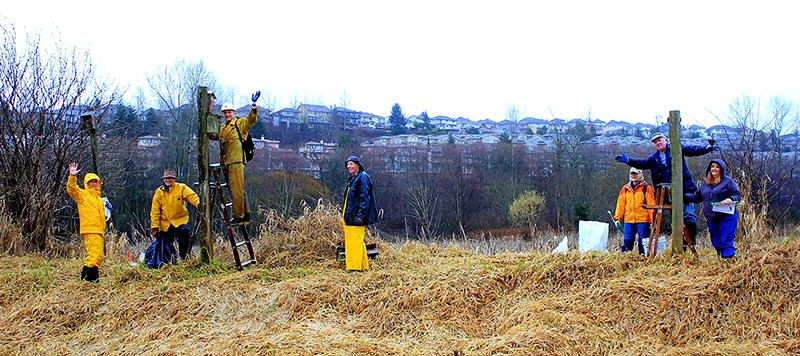Without a doubt, spring is just around the corner. Already, the small white blossoms of Indian plum have appeared while the buds of red-flowering current and salmonberry are swelling and promise to open soon at the first hint of warm sunshine.
Like many people, spring is my favourite time of year. I await increasing evidence of it with great anticipation. Although I was born and raised in Saskatchewan, where April blizzards are par for the course, I have now turned into a west coast wimp with a penchant for flowers in February.
The birds know that spring is just around the corner, too. The mixed-species flocks of small birds that form over winter have disbanded; resident birds are now preoccupied in a search for mates and suitable nesting sites.
The Anna’s hummingbirds, a recent new resident in the Lower Mainland (thanks to those who maintain hummingbird feeders over the winter), are already on their nests. Once the red-flowering current blooms, we can expect them to be joined by the rufous hummingbirds, which migrate from Mexico all the way to Alaska to nest every summer. Swallows should soon be appearing after strenuous migrations from their winter habitat in Central and South America.
For the Burke Mountain Naturalists, February is the month for nest box cleaning. We have installed and maintain hundreds of boxes in Colony Farm and Minnekhada regional parks, DeBoville Slough and Widgeon Marsh Regional Reserve. Every spring, these boxes need to be checked, cleaned and given a small handful of fresh wood shavings on which swallows and chickadees will construct their nests.
While many species of birds build cup-shaped nests on the ground or in bushes and trees, some species seek out cavities in decaying trees as nesting sites. These birds include chickadees, nuthatches, swallows and some ducks as well as all members of the woodpecker family.
Because woodpeckers have no problem drilling cavities in trees, they are less inclined to use a man-made nest box. However, the species that lack these carpentry skills will often use a nest box if the entrance hole is sufficiently small to deter predators and the location meets their preferences. Because decaying trees are often removed from parks for public safety, the provision of nest boxes helps to provide a satisfactory alternative.
When BMN volunteers first started putting out nest boxes for swallows, the success rate for use was typically in the 60 to 80% range. This was good as swallows are a beneficial species that consume a number of insect pests, including mosquitoes. But in recent years, our success rate has dropped to approximately 30 to 50%. This is because there is a new species of wasp, the European paper wasp, in the Lower Mainland.
This wasp also has a strong preference for cavities in which to place their nests. Unlike our native wasps, these wasps nest early in the season, which puts them in direct competition with the swallows. Although the presence of a European paper wasp nest does not always prevent the use of the nest box by swallows, there is a correlation between the presence of these wasps and the absence of swallows.
While we are disappointed with the reduced use of our nest boxes by swallows, we have noticed that when the nest boxes are installed in pairs, often one is used by swallows while the other is taken over by the wasps.
European papers wasps were originally found in southern Europe but have moved north as the climate has warmed. They were accidentally introduced to North America in 1978 and arrived on Vancouver Island in 2003 and from there have spread across southern B.C. They are considered to be an invasive pest in areas where there are orchards and vineyards. They apparently damage the skin of fruit by biting into it and can spread fungal and yeast diseases that harm fruit crops.
European paper wasps can be distinguished from native wasps by their longer legs and orange/black antennae (native wasps have antennae that are completely black). The nest of a European paper wasp is also easily identified by its inverted umbrella shape and the absence of a covering over the cells in which the eggs are laid.
You might want to consider putting up a nest box in your backyard. If so, there is information on the Burke Mountain Naturalist website (www.bmn.bc.ca) on how to build suitable nest boxes for chickadees and swallows. Swallows prefer open habitat, often near water, so if you or your neighbour has a swimming pool, you might be able to attract swallows. Chickadees prefer more forested habitat and require branches close to their nest boxes on which they can perch and check that no predator is watching them before they enter their box. Installing a box on the side of a house or garden shed can prevent access by predators such as raccoons or cats. It can be a delightful experience for the whole family to watch birds raise their young.
--Elaine Golds is a Port Moody environmentalist who is conservation/education chair of the Burke Mountain Naturalists and member of the boards of the Colony Farm Park Association and the Port Moody Ecological Society.



